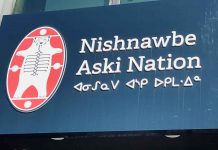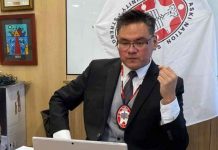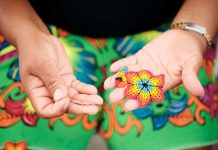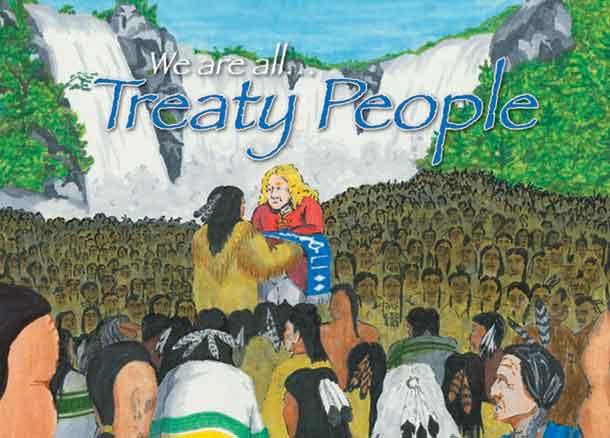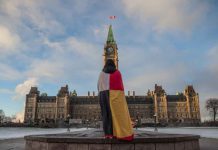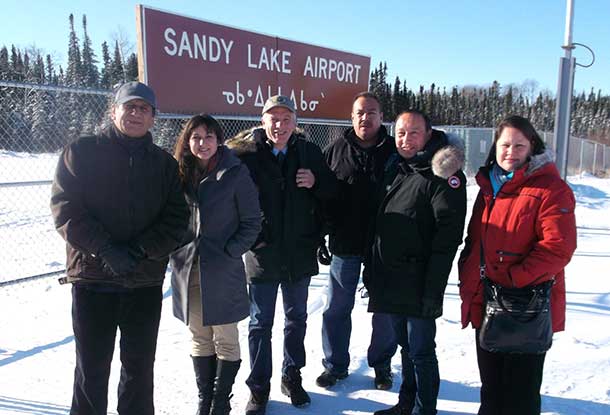
SANDY LAKE FN – ANISHINABEK – Members from the Sandy Lake First Nations community, gathered at their Youth Centre on the evening of November 13 to attend the opening of a two-day presentation concerning the role of jury members and an explanation of how coronary inquests are conducted, by a team put together by Nishnawabe Aski Nation whose members included NAN former Deputy Grand Chief Terry Waboose, Sam Achneepinescum, Julian Falconer NAN legal representative and lawyer Meaghan T. Daniel both from Falconer LLP, an observer from the Ontario Ministry of the Attorney General Jodie-Lynn Waddilove and John Cutfeet and Jerry Sawanas who attended in the role of translators.
The lack of representation on juries relating to inquests and trials involving First Nations people has been a problem which until recently has been largely ignored by the Provincial Government.
Although requests for jury duty have been sent out to communities by letters addressed to Chiefs and Councils to be distributed amongst community members, they are perceived by many recipients as a threat due to misinterpretation of the document wording which has resulted in a lack of volunteers.
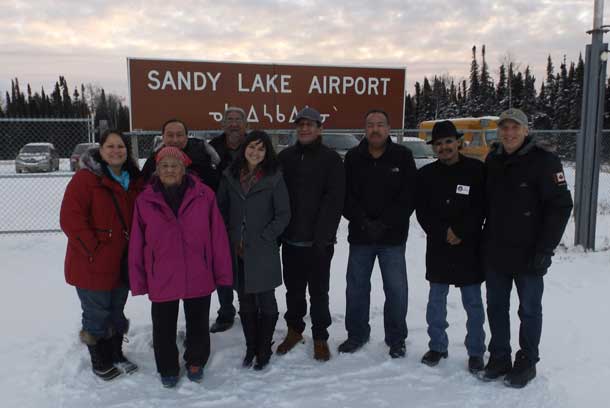
At present, there are 12 inquests that are unable to go forward including the mysterious deaths of seven students in Thunder Bay, all of whom came from Northern Communities to further their education. The fact that five have died in similar circumstances with their bodies recovered from the McIntyre River (4) the other recovered from Kaministiquai River has led to speculation on the cause of death and hastened the need for inquests.
The urgent need for First Nation jury representation, was first highlighted in a report put forward by former Supreme Court Justice, the Honourable Frank Iacobucci who was appointed to report on First Nation representation on Ontario jury rolls in August 2011. Upon its release, the report was followed up by the government and wheels were set in motion, culminating in NAN putting together a team to visit the Northern Communities.
Following a closed meeting with Chief Bart Meekis and Council members in the afternoon the representatives adjourned to the centre for dinner which commenced at 7pm with a prayer said by Elder Adelaide Meekis. Waboose then opened the event by introducing himself and the other members of the party then went on to explain that, “The issue we are going to talk about to you is the jury role with respect to inquests, that is our purpose here. But more importantly to tell you about the process, the background of why we are here and also to ask for your assistance now and if you so desire, so once we complete the presentation we are asking for volunteers to serve on the inquest juries.”
He then introduced Falconer who spoke of the role that jury members play in relation to coroners inquests and the need for First Nation representation on juries ,“The idea is to provide you legal information and legal advise, to answer questions and most importantly, to try and give you the opportunity to decide for yourself what we are discussing is a good idea. For far too long, key information that First Nations need isn’t given to them, respect isn’t extended. You get envelopes in the mail with her Majesty the Queen on them and you are supposed to do what you are told and then they found they could not get jurists together because community members do not respond to that. The Justice System has not been kind to First Nations and the Information Circulars ( provided on the night ) are about trying to protect your communities and a coroners inquest is one way of doing this.”
He concluded, “They can’t convene 12 inquests in the North right now, because they can’t get juries together because First Nation are not on the jury roles and the juries cannot go forward without First Nation participation, there is a benefit in doing this, because you become involved on your terms, you make the decision we can‘t do that for you. This is intended to create integrity in the system, it is intended to give community a voice on their own terms.”
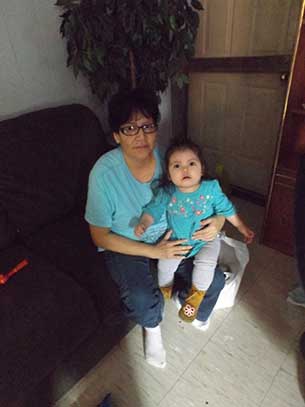
He then invited members of the community to ask questions for him to answer about the presentation.
Among those in attendance were Lorene Morriseau whose 17 year old son Kyle’s body was found in the McIntyre river in Thunder Bay on November 10 2009.
At the conclusion of the evening she commented, “I am hoping that things will work out to help the families get over the losses they have been going through. It’s been too long and its time to do something and I feel that by getting volunteers to appear on juries will hopefully get the inquest process moving faster.”
Casey Fiddler there with her partner Rubin Kakekagumick concurred,“ I think it’s a good idea for the families and friends that don’t know anything about the inquests. I understand now what a jury does, it was explained well and I would consider doing jury duty.”
The second day started with a luncheon and a thank-you speech from Chief Meekis after which one on one sessions with interested community members were conducted by team members.
At the close of the session,48 people had volunteered their services.
Terrance Meekis who is Justice Coordinator for the Sandy Lake Justice Committee and also runs the Band radio station was one of the first to volunteer,
“I think it’s important for people to get closure and healing from the inquests. I got the emails and I was asked to coordinate the meetings so I thought it was important with all the inquests that are waiting to become involved. It took a bit of time to explain to some of the people what the process is about and once we broadcast on the radio we got a greater response. I feel positive that once the information sessions are completed there will be a speeding up of the inquest process” he said.
Chief Meekis was pleased with the outcome of the information session.
“I am very happy with the way the presentation went at the Band office, also at the radio station and here at the Youth Centre. It is an historic moment for Sandy Lake. It’s been a 104 years since we signed the treaty in 1910 and we have been having injustice to our people since that time and we have been fighting the good fight to have justice for our people and part of this, is having the Attorney General along with NAN asking our First Nations to be involved in the voluntary coroners inquests. There is a movement to work together and to come up with a solution and a chance to work together.”
Chief Meekis added, “For my people to step up and become volunteer jurists for the coroner is great. So what I feel is if that happens there will be more justice for our people which would make finding out what happened and also with the coroner’s recommendations while our people are involved in the jury process and if selected will be able to find out and put closure to these inquests for the families and I would hope that this leads to positive changes for the First Nations people and for the future of our children.”
Waboose was optimistic, “This is our first community so I think there will be a few things we have learned that will guide us as we go to the other communities. We will pick up little things that will help us to make people understand more what the process is, changing some of the language and re-defining the terms so that people can fully comprehend what we said because it is a complicated process so eventually getting to the point where people can understand in layman’s terms. I guess that is one thing we will take back to NAN when we do our first debrief. For the first evening I think we had a crowd that showed an interest and getting volunteers was a good step. It wasn’t really our intent to solicit volunteers we just wanted to provide the basic information but I certainly feel that we are a bit ahead now, those that were there will certainly talk to other individuals in the community, some did say that they were here to talk to other people they know. It’s all numbers.”
He continued, “Sandy Lake from what I understand was chosen first at the request of the community, they felt that it would be important to show that that they were committed to this process and show support they obviously felt that this was important to them, so the people at Nishnawabi Aski Nation that developed the schedule felt that Sandy Lake would be a good place to start. As for NAN’s part we are looking at going to about 10 to 12 communities. The office at NAN is trying to arrange the other visits selection based on their size large, small, remote.
Some of them will be in the East and West and obviously the central part of NAN so there is a good cross section of communities that will be visited and I am optimistic that we will have at least the 12 that NAN were requested to do done by March next year.
Finally at the end of the process, we will ideally have a sufficient list of volunteers that are willing to serve on juries that will then be shared with the Provincial Attorney General Authorities.”
Falconer stated,“ I see this exercise as important on a number of fronts. First of all, it is a rare occasion when First Nations are asked to be involved in the justice system on their terms, by that I mean the terror idea behind the volunteer issue is that it takes out the compulsion piece, it takes out Her Majesty the Queen using the strong arm of the law to bring First Nations to places they don’t want to be, by approaching this this way, I think we create a new opportunity, an opportunity to work in partnership.
This is different and I think today and yesterday’s reaction from the Sandy Lake community is a good indication.
There is truly a desire to go forward in many areas of the justice system, both sides lack an understanding on how to go forward and what I think is important is that it’s clearly a working partnership. When folks are given enough information to make important decisions, consequently when they are given the chance to help their community in a non political way, success is the ultimate result.”
Geoff Shields


